E-Business Technologies
VerifiedAdded on 2023/03/21
|17
|4365
|84
AI Summary
This report discusses the payment methods used in e-commerce and the security risks associated with them. It covers topics such as e-payment using credit or debit cards, e-payment using third-party processors, and smart cards. The report also addresses security risks such as e-commerce fraud and lack of anonymity. Solutions for payment security issues, such as proper verification systems and encryption of data, are also discussed. Overall, this report provides a comprehensive overview of e-business technologies and their impact on payment security.
Contribute Materials
Your contribution can guide someone’s learning journey. Share your
documents today.
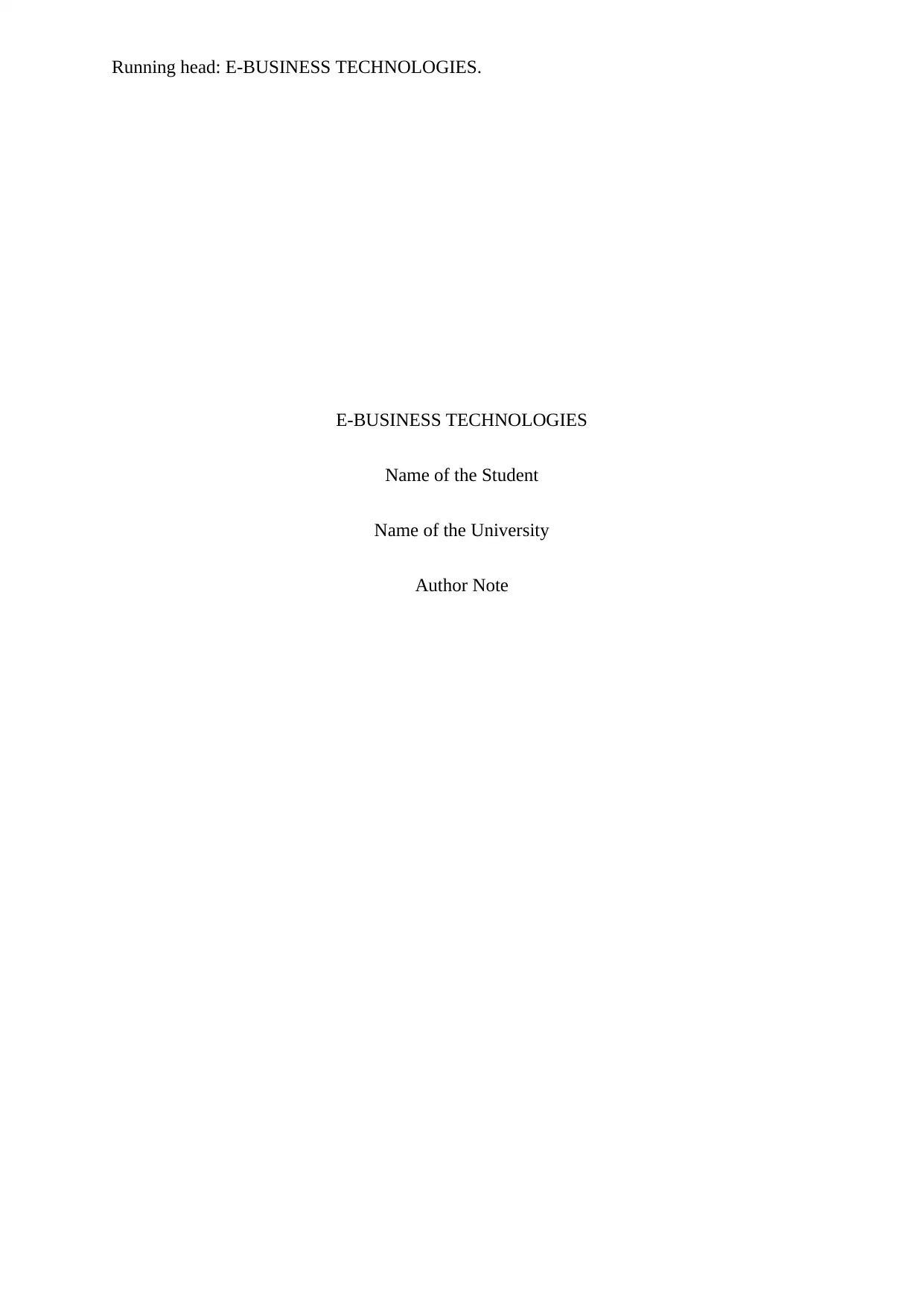
Running head: E-BUSINESS TECHNOLOGIES.
E-BUSINESS TECHNOLOGIES
Name of the Student
Name of the University
Author Note
E-BUSINESS TECHNOLOGIES
Name of the Student
Name of the University
Author Note
Secure Best Marks with AI Grader
Need help grading? Try our AI Grader for instant feedback on your assignments.
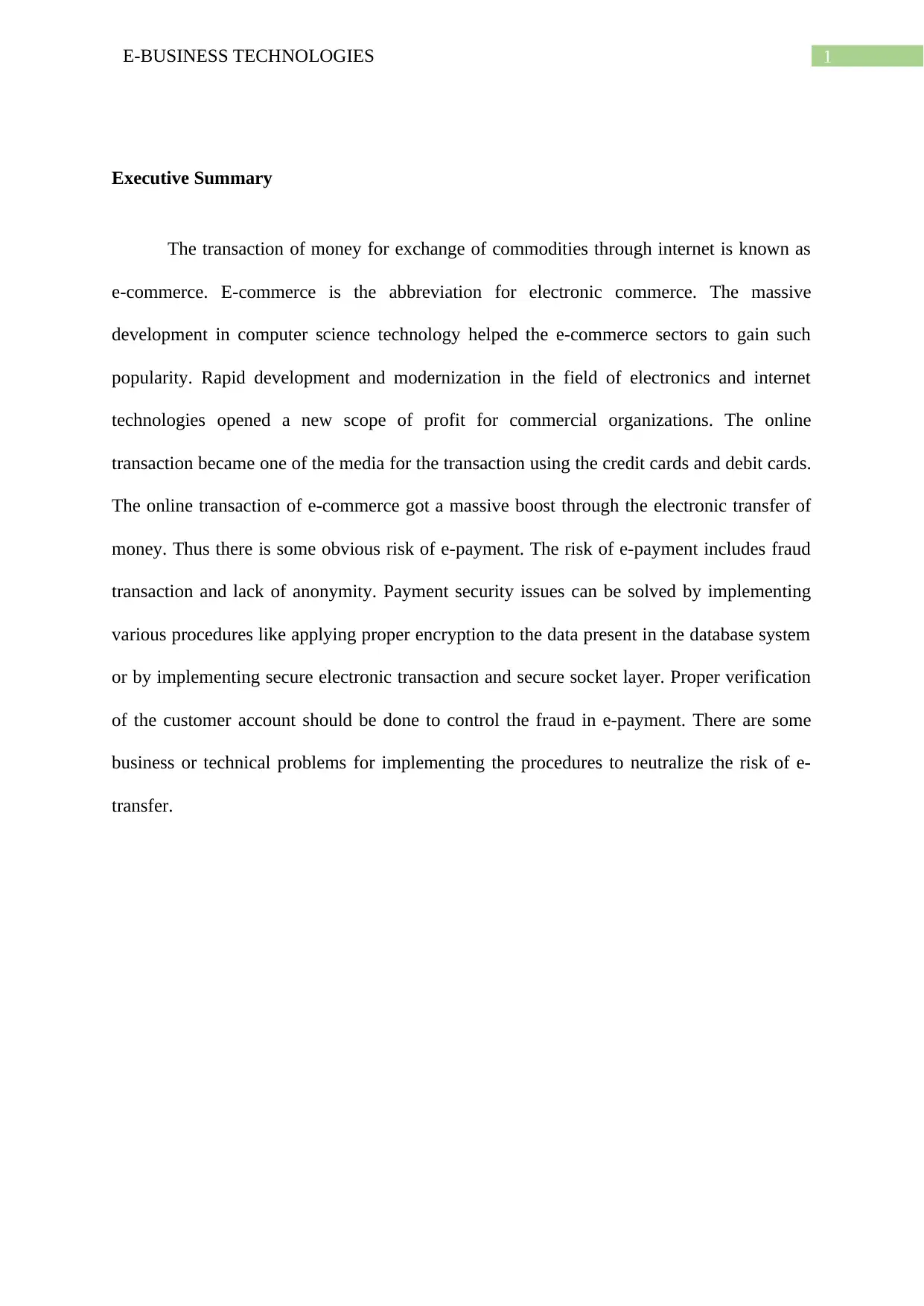
1E-BUSINESS TECHNOLOGIES
Executive Summary
The transaction of money for exchange of commodities through internet is known as
e-commerce. E-commerce is the abbreviation for electronic commerce. The massive
development in computer science technology helped the e-commerce sectors to gain such
popularity. Rapid development and modernization in the field of electronics and internet
technologies opened a new scope of profit for commercial organizations. The online
transaction became one of the media for the transaction using the credit cards and debit cards.
The online transaction of e-commerce got a massive boost through the electronic transfer of
money. Thus there is some obvious risk of e-payment. The risk of e-payment includes fraud
transaction and lack of anonymity. Payment security issues can be solved by implementing
various procedures like applying proper encryption to the data present in the database system
or by implementing secure electronic transaction and secure socket layer. Proper verification
of the customer account should be done to control the fraud in e-payment. There are some
business or technical problems for implementing the procedures to neutralize the risk of e-
transfer.
Executive Summary
The transaction of money for exchange of commodities through internet is known as
e-commerce. E-commerce is the abbreviation for electronic commerce. The massive
development in computer science technology helped the e-commerce sectors to gain such
popularity. Rapid development and modernization in the field of electronics and internet
technologies opened a new scope of profit for commercial organizations. The online
transaction became one of the media for the transaction using the credit cards and debit cards.
The online transaction of e-commerce got a massive boost through the electronic transfer of
money. Thus there is some obvious risk of e-payment. The risk of e-payment includes fraud
transaction and lack of anonymity. Payment security issues can be solved by implementing
various procedures like applying proper encryption to the data present in the database system
or by implementing secure electronic transaction and secure socket layer. Proper verification
of the customer account should be done to control the fraud in e-payment. There are some
business or technical problems for implementing the procedures to neutralize the risk of e-
transfer.
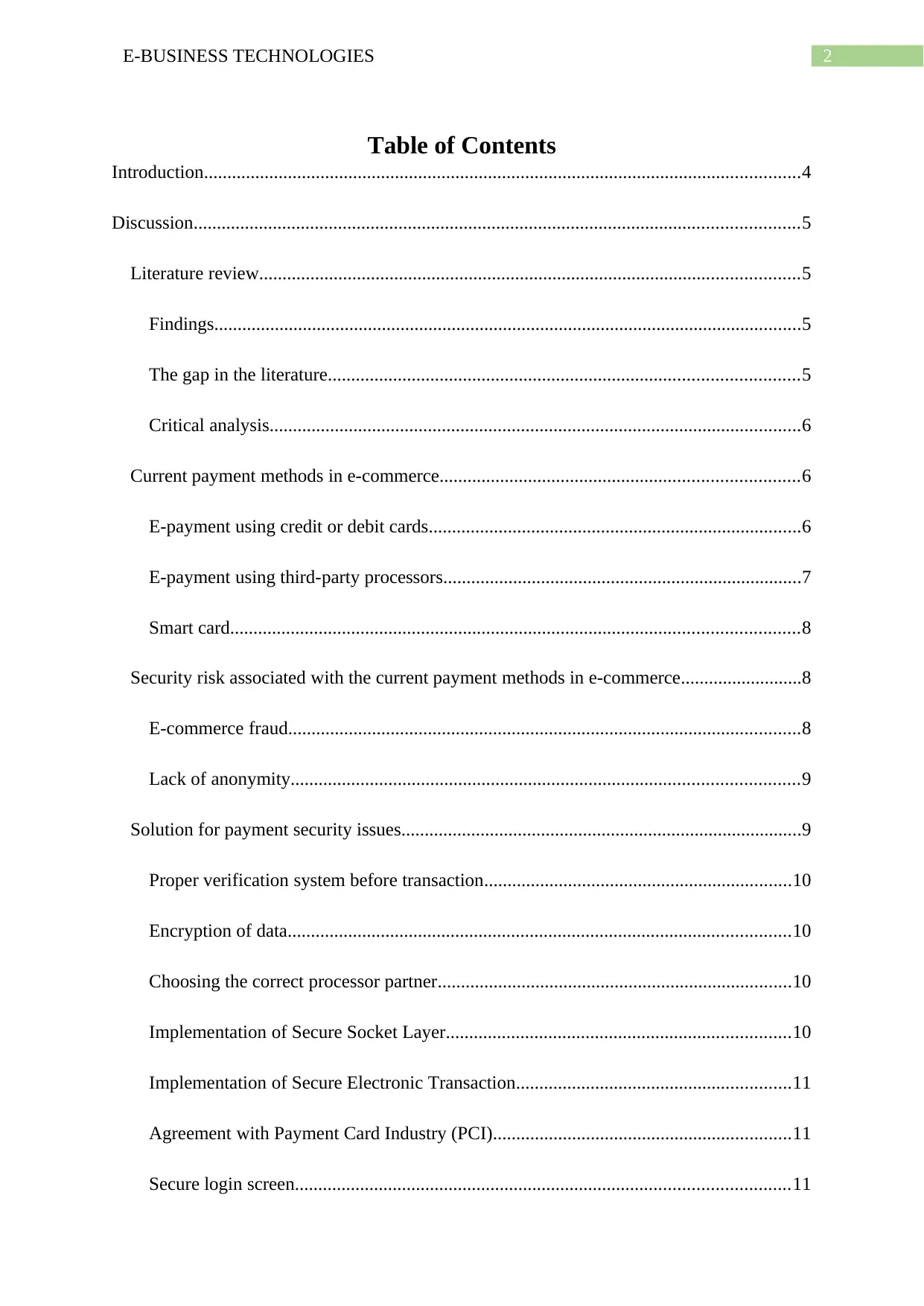
2E-BUSINESS TECHNOLOGIES
Table of Contents
Introduction................................................................................................................................4
Discussion..................................................................................................................................5
Literature review....................................................................................................................5
Findings..............................................................................................................................5
The gap in the literature.....................................................................................................5
Critical analysis..................................................................................................................6
Current payment methods in e-commerce.............................................................................6
E-payment using credit or debit cards................................................................................6
E-payment using third-party processors.............................................................................7
Smart card..........................................................................................................................8
Security risk associated with the current payment methods in e-commerce..........................8
E-commerce fraud..............................................................................................................8
Lack of anonymity.............................................................................................................9
Solution for payment security issues......................................................................................9
Proper verification system before transaction..................................................................10
Encryption of data............................................................................................................10
Choosing the correct processor partner............................................................................10
Implementation of Secure Socket Layer..........................................................................10
Implementation of Secure Electronic Transaction...........................................................11
Agreement with Payment Card Industry (PCI)................................................................11
Secure login screen..........................................................................................................11
Table of Contents
Introduction................................................................................................................................4
Discussion..................................................................................................................................5
Literature review....................................................................................................................5
Findings..............................................................................................................................5
The gap in the literature.....................................................................................................5
Critical analysis..................................................................................................................6
Current payment methods in e-commerce.............................................................................6
E-payment using credit or debit cards................................................................................6
E-payment using third-party processors.............................................................................7
Smart card..........................................................................................................................8
Security risk associated with the current payment methods in e-commerce..........................8
E-commerce fraud..............................................................................................................8
Lack of anonymity.............................................................................................................9
Solution for payment security issues......................................................................................9
Proper verification system before transaction..................................................................10
Encryption of data............................................................................................................10
Choosing the correct processor partner............................................................................10
Implementation of Secure Socket Layer..........................................................................10
Implementation of Secure Electronic Transaction...........................................................11
Agreement with Payment Card Industry (PCI)................................................................11
Secure login screen..........................................................................................................11

3E-BUSINESS TECHNOLOGIES
Business or technical challenges while solving payment security problems.......................11
The future of information and payment security trends in e-commerce..............................12
Real-time security............................................................................................................12
MasterCard identity checking:.........................................................................................12
Multilayered intelligence.................................................................................................12
Implementation of Artificial Intelligence (AI), Internet of Things (IoT) and
cryptocurrency..................................................................................................................13
Conclusion................................................................................................................................13
References................................................................................................................................14
Business or technical challenges while solving payment security problems.......................11
The future of information and payment security trends in e-commerce..............................12
Real-time security............................................................................................................12
MasterCard identity checking:.........................................................................................12
Multilayered intelligence.................................................................................................12
Implementation of Artificial Intelligence (AI), Internet of Things (IoT) and
cryptocurrency..................................................................................................................13
Conclusion................................................................................................................................13
References................................................................................................................................14
Secure Best Marks with AI Grader
Need help grading? Try our AI Grader for instant feedback on your assignments.
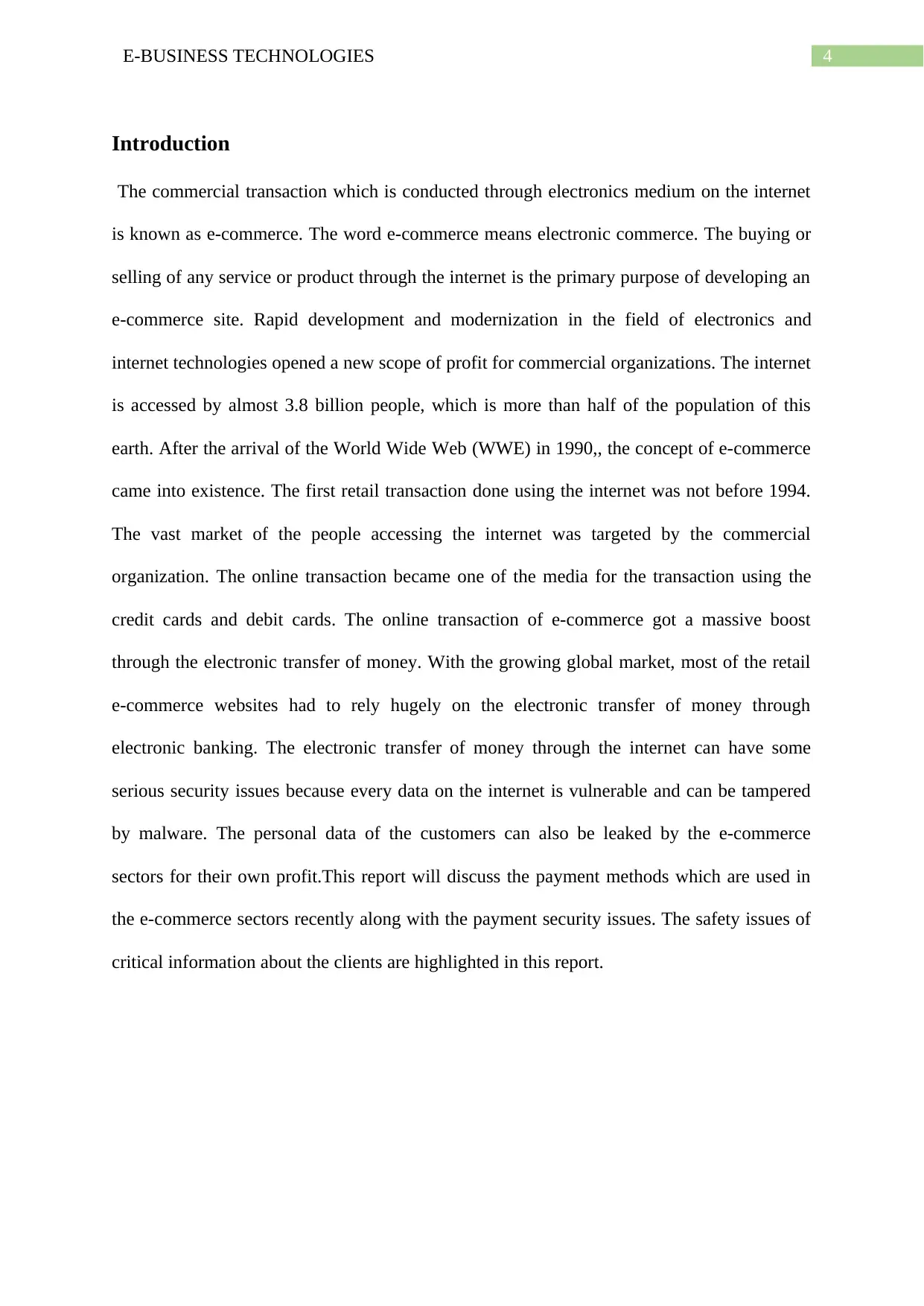
4E-BUSINESS TECHNOLOGIES
Introduction
The commercial transaction which is conducted through electronics medium on the internet
is known as e-commerce. The word e-commerce means electronic commerce. The buying or
selling of any service or product through the internet is the primary purpose of developing an
e-commerce site. Rapid development and modernization in the field of electronics and
internet technologies opened a new scope of profit for commercial organizations. The internet
is accessed by almost 3.8 billion people, which is more than half of the population of this
earth. After the arrival of the World Wide Web (WWE) in 1990,, the concept of e-commerce
came into existence. The first retail transaction done using the internet was not before 1994.
The vast market of the people accessing the internet was targeted by the commercial
organization. The online transaction became one of the media for the transaction using the
credit cards and debit cards. The online transaction of e-commerce got a massive boost
through the electronic transfer of money. With the growing global market, most of the retail
e-commerce websites had to rely hugely on the electronic transfer of money through
electronic banking. The electronic transfer of money through the internet can have some
serious security issues because every data on the internet is vulnerable and can be tampered
by malware. The personal data of the customers can also be leaked by the e-commerce
sectors for their own profit.This report will discuss the payment methods which are used in
the e-commerce sectors recently along with the payment security issues. The safety issues of
critical information about the clients are highlighted in this report.
Introduction
The commercial transaction which is conducted through electronics medium on the internet
is known as e-commerce. The word e-commerce means electronic commerce. The buying or
selling of any service or product through the internet is the primary purpose of developing an
e-commerce site. Rapid development and modernization in the field of electronics and
internet technologies opened a new scope of profit for commercial organizations. The internet
is accessed by almost 3.8 billion people, which is more than half of the population of this
earth. After the arrival of the World Wide Web (WWE) in 1990,, the concept of e-commerce
came into existence. The first retail transaction done using the internet was not before 1994.
The vast market of the people accessing the internet was targeted by the commercial
organization. The online transaction became one of the media for the transaction using the
credit cards and debit cards. The online transaction of e-commerce got a massive boost
through the electronic transfer of money. With the growing global market, most of the retail
e-commerce websites had to rely hugely on the electronic transfer of money through
electronic banking. The electronic transfer of money through the internet can have some
serious security issues because every data on the internet is vulnerable and can be tampered
by malware. The personal data of the customers can also be leaked by the e-commerce
sectors for their own profit.This report will discuss the payment methods which are used in
the e-commerce sectors recently along with the payment security issues. The safety issues of
critical information about the clients are highlighted in this report.
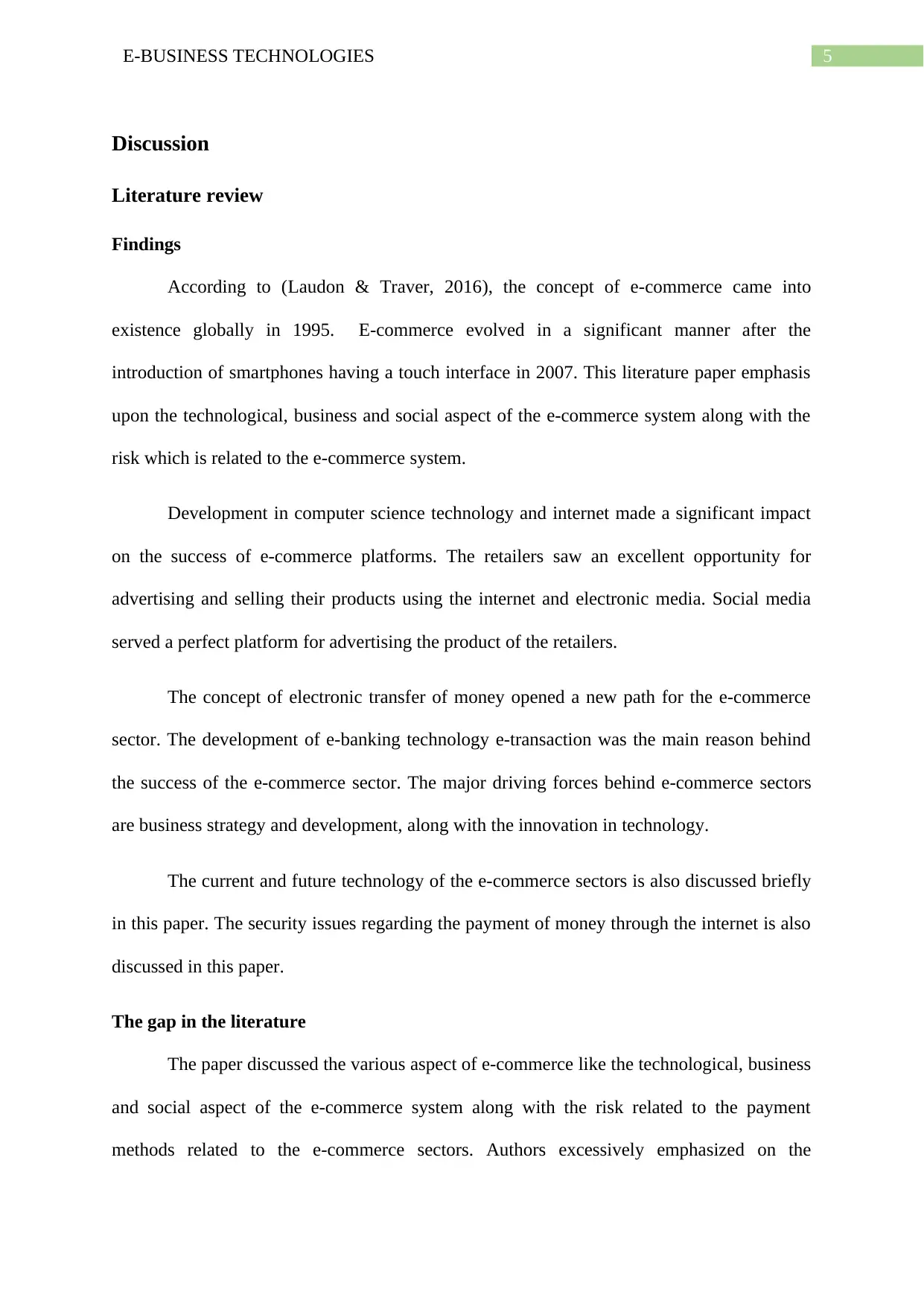
5E-BUSINESS TECHNOLOGIES
Discussion
Literature review
Findings
According to (Laudon & Traver, 2016), the concept of e-commerce came into
existence globally in 1995. E-commerce evolved in a significant manner after the
introduction of smartphones having a touch interface in 2007. This literature paper emphasis
upon the technological, business and social aspect of the e-commerce system along with the
risk which is related to the e-commerce system.
Development in computer science technology and internet made a significant impact
on the success of e-commerce platforms. The retailers saw an excellent opportunity for
advertising and selling their products using the internet and electronic media. Social media
served a perfect platform for advertising the product of the retailers.
The concept of electronic transfer of money opened a new path for the e-commerce
sector. The development of e-banking technology e-transaction was the main reason behind
the success of the e-commerce sector. The major driving forces behind e-commerce sectors
are business strategy and development, along with the innovation in technology.
The current and future technology of the e-commerce sectors is also discussed briefly
in this paper. The security issues regarding the payment of money through the internet is also
discussed in this paper.
The gap in the literature
The paper discussed the various aspect of e-commerce like the technological, business
and social aspect of the e-commerce system along with the risk related to the payment
methods related to the e-commerce sectors. Authors excessively emphasized on the
Discussion
Literature review
Findings
According to (Laudon & Traver, 2016), the concept of e-commerce came into
existence globally in 1995. E-commerce evolved in a significant manner after the
introduction of smartphones having a touch interface in 2007. This literature paper emphasis
upon the technological, business and social aspect of the e-commerce system along with the
risk which is related to the e-commerce system.
Development in computer science technology and internet made a significant impact
on the success of e-commerce platforms. The retailers saw an excellent opportunity for
advertising and selling their products using the internet and electronic media. Social media
served a perfect platform for advertising the product of the retailers.
The concept of electronic transfer of money opened a new path for the e-commerce
sector. The development of e-banking technology e-transaction was the main reason behind
the success of the e-commerce sector. The major driving forces behind e-commerce sectors
are business strategy and development, along with the innovation in technology.
The current and future technology of the e-commerce sectors is also discussed briefly
in this paper. The security issues regarding the payment of money through the internet is also
discussed in this paper.
The gap in the literature
The paper discussed the various aspect of e-commerce like the technological, business
and social aspect of the e-commerce system along with the risk related to the payment
methods related to the e-commerce sectors. Authors excessively emphasized on the
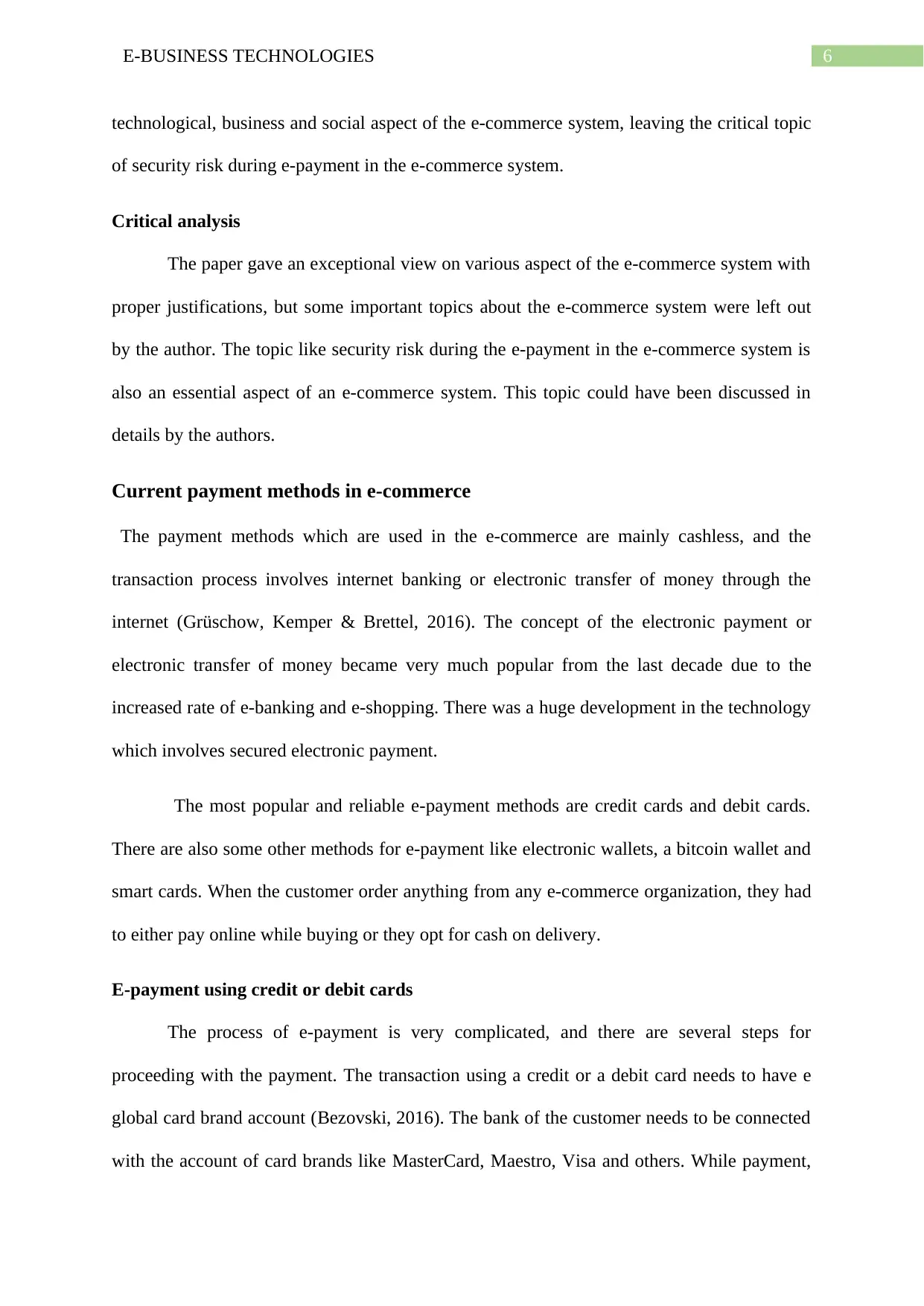
6E-BUSINESS TECHNOLOGIES
technological, business and social aspect of the e-commerce system, leaving the critical topic
of security risk during e-payment in the e-commerce system.
Critical analysis
The paper gave an exceptional view on various aspect of the e-commerce system with
proper justifications, but some important topics about the e-commerce system were left out
by the author. The topic like security risk during the e-payment in the e-commerce system is
also an essential aspect of an e-commerce system. This topic could have been discussed in
details by the authors.
Current payment methods in e-commerce
The payment methods which are used in the e-commerce are mainly cashless, and the
transaction process involves internet banking or electronic transfer of money through the
internet (Grüschow, Kemper & Brettel, 2016). The concept of the electronic payment or
electronic transfer of money became very much popular from the last decade due to the
increased rate of e-banking and e-shopping. There was a huge development in the technology
which involves secured electronic payment.
The most popular and reliable e-payment methods are credit cards and debit cards.
There are also some other methods for e-payment like electronic wallets, a bitcoin wallet and
smart cards. When the customer order anything from any e-commerce organization, they had
to either pay online while buying or they opt for cash on delivery.
E-payment using credit or debit cards
The process of e-payment is very complicated, and there are several steps for
proceeding with the payment. The transaction using a credit or a debit card needs to have e
global card brand account (Bezovski, 2016). The bank of the customer needs to be connected
with the account of card brands like MasterCard, Maestro, Visa and others. While payment,
technological, business and social aspect of the e-commerce system, leaving the critical topic
of security risk during e-payment in the e-commerce system.
Critical analysis
The paper gave an exceptional view on various aspect of the e-commerce system with
proper justifications, but some important topics about the e-commerce system were left out
by the author. The topic like security risk during the e-payment in the e-commerce system is
also an essential aspect of an e-commerce system. This topic could have been discussed in
details by the authors.
Current payment methods in e-commerce
The payment methods which are used in the e-commerce are mainly cashless, and the
transaction process involves internet banking or electronic transfer of money through the
internet (Grüschow, Kemper & Brettel, 2016). The concept of the electronic payment or
electronic transfer of money became very much popular from the last decade due to the
increased rate of e-banking and e-shopping. There was a huge development in the technology
which involves secured electronic payment.
The most popular and reliable e-payment methods are credit cards and debit cards.
There are also some other methods for e-payment like electronic wallets, a bitcoin wallet and
smart cards. When the customer order anything from any e-commerce organization, they had
to either pay online while buying or they opt for cash on delivery.
E-payment using credit or debit cards
The process of e-payment is very complicated, and there are several steps for
proceeding with the payment. The transaction using a credit or a debit card needs to have e
global card brand account (Bezovski, 2016). The bank of the customer needs to be connected
with the account of card brands like MasterCard, Maestro, Visa and others. While payment,
Paraphrase This Document
Need a fresh take? Get an instant paraphrase of this document with our AI Paraphraser
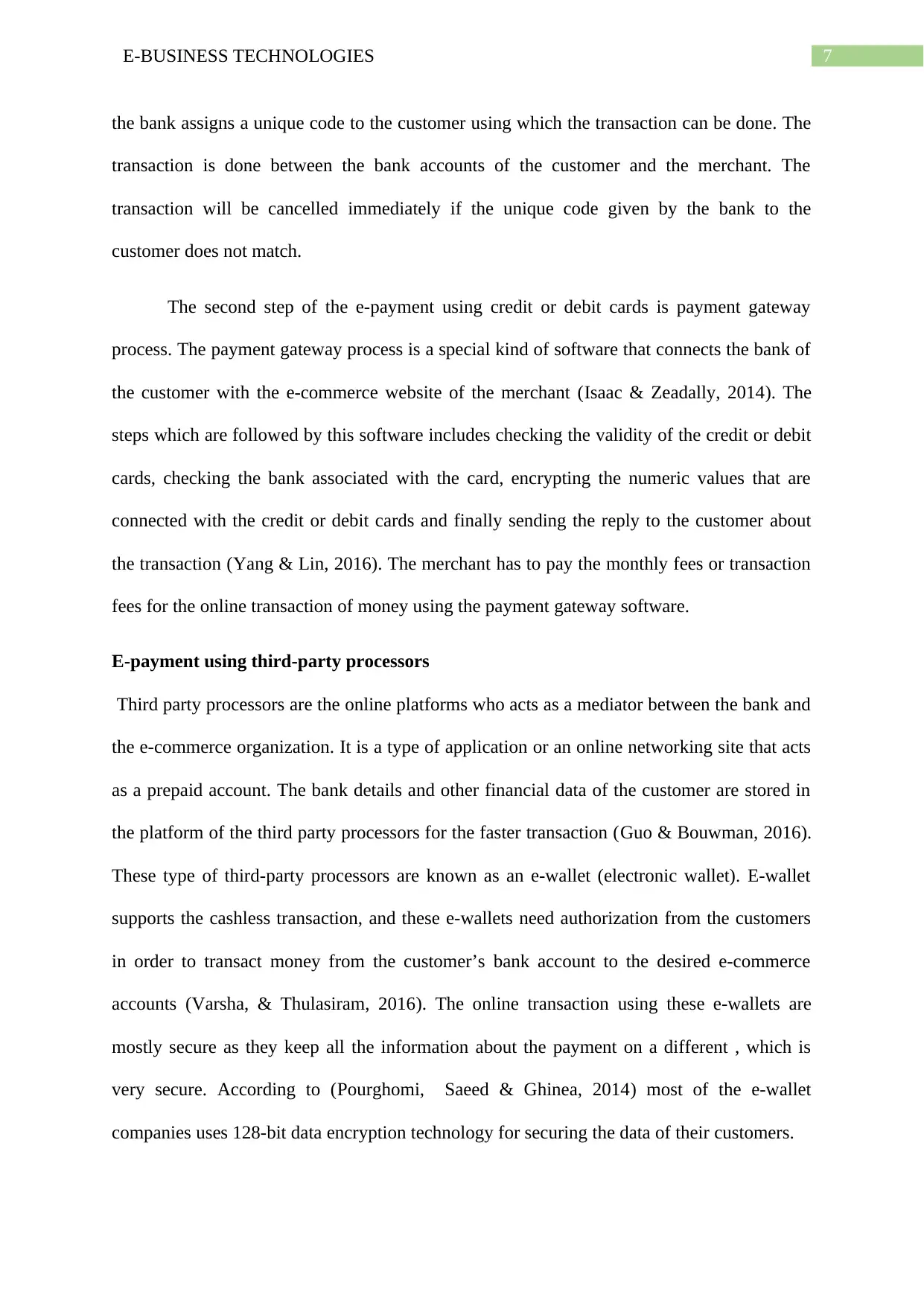
7E-BUSINESS TECHNOLOGIES
the bank assigns a unique code to the customer using which the transaction can be done. The
transaction is done between the bank accounts of the customer and the merchant. The
transaction will be cancelled immediately if the unique code given by the bank to the
customer does not match.
The second step of the e-payment using credit or debit cards is payment gateway
process. The payment gateway process is a special kind of software that connects the bank of
the customer with the e-commerce website of the merchant (Isaac & Zeadally, 2014). The
steps which are followed by this software includes checking the validity of the credit or debit
cards, checking the bank associated with the card, encrypting the numeric values that are
connected with the credit or debit cards and finally sending the reply to the customer about
the transaction (Yang & Lin, 2016). The merchant has to pay the monthly fees or transaction
fees for the online transaction of money using the payment gateway software.
E-payment using third-party processors
Third party processors are the online platforms who acts as a mediator between the bank and
the e-commerce organization. It is a type of application or an online networking site that acts
as a prepaid account. The bank details and other financial data of the customer are stored in
the platform of the third party processors for the faster transaction (Guo & Bouwman, 2016).
These type of third-party processors are known as an e-wallet (electronic wallet). E-wallet
supports the cashless transaction, and these e-wallets need authorization from the customers
in order to transact money from the customer’s bank account to the desired e-commerce
accounts (Varsha, & Thulasiram, 2016). The online transaction using these e-wallets are
mostly secure as they keep all the information about the payment on a different , which is
very secure. According to (Pourghomi, Saeed & Ghinea, 2014) most of the e-wallet
companies uses 128-bit data encryption technology for securing the data of their customers.
the bank assigns a unique code to the customer using which the transaction can be done. The
transaction is done between the bank accounts of the customer and the merchant. The
transaction will be cancelled immediately if the unique code given by the bank to the
customer does not match.
The second step of the e-payment using credit or debit cards is payment gateway
process. The payment gateway process is a special kind of software that connects the bank of
the customer with the e-commerce website of the merchant (Isaac & Zeadally, 2014). The
steps which are followed by this software includes checking the validity of the credit or debit
cards, checking the bank associated with the card, encrypting the numeric values that are
connected with the credit or debit cards and finally sending the reply to the customer about
the transaction (Yang & Lin, 2016). The merchant has to pay the monthly fees or transaction
fees for the online transaction of money using the payment gateway software.
E-payment using third-party processors
Third party processors are the online platforms who acts as a mediator between the bank and
the e-commerce organization. It is a type of application or an online networking site that acts
as a prepaid account. The bank details and other financial data of the customer are stored in
the platform of the third party processors for the faster transaction (Guo & Bouwman, 2016).
These type of third-party processors are known as an e-wallet (electronic wallet). E-wallet
supports the cashless transaction, and these e-wallets need authorization from the customers
in order to transact money from the customer’s bank account to the desired e-commerce
accounts (Varsha, & Thulasiram, 2016). The online transaction using these e-wallets are
mostly secure as they keep all the information about the payment on a different , which is
very secure. According to (Pourghomi, Saeed & Ghinea, 2014) most of the e-wallet
companies uses 128-bit data encryption technology for securing the data of their customers.
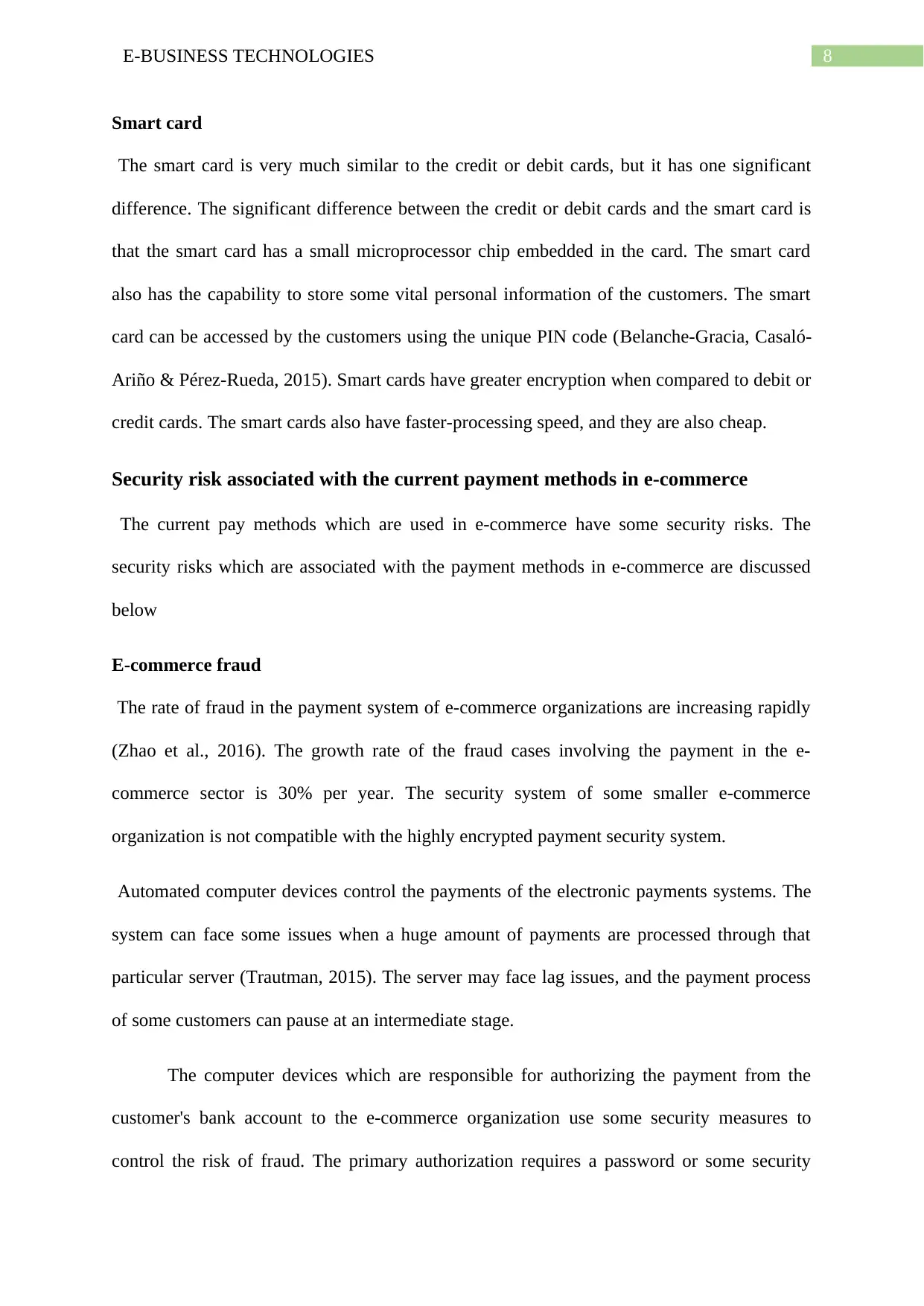
8E-BUSINESS TECHNOLOGIES
Smart card
The smart card is very much similar to the credit or debit cards, but it has one significant
difference. The significant difference between the credit or debit cards and the smart card is
that the smart card has a small microprocessor chip embedded in the card. The smart card
also has the capability to store some vital personal information of the customers. The smart
card can be accessed by the customers using the unique PIN code (Belanche-Gracia, Casaló-
Ariño & Pérez-Rueda, 2015). Smart cards have greater encryption when compared to debit or
credit cards. The smart cards also have faster-processing speed, and they are also cheap.
Security risk associated with the current payment methods in e-commerce
The current pay methods which are used in e-commerce have some security risks. The
security risks which are associated with the payment methods in e-commerce are discussed
below
E-commerce fraud
The rate of fraud in the payment system of e-commerce organizations are increasing rapidly
(Zhao et al., 2016). The growth rate of the fraud cases involving the payment in the e-
commerce sector is 30% per year. The security system of some smaller e-commerce
organization is not compatible with the highly encrypted payment security system.
Automated computer devices control the payments of the electronic payments systems. The
system can face some issues when a huge amount of payments are processed through that
particular server (Trautman, 2015). The server may face lag issues, and the payment process
of some customers can pause at an intermediate stage.
The computer devices which are responsible for authorizing the payment from the
customer's bank account to the e-commerce organization use some security measures to
control the risk of fraud. The primary authorization requires a password or some security
Smart card
The smart card is very much similar to the credit or debit cards, but it has one significant
difference. The significant difference between the credit or debit cards and the smart card is
that the smart card has a small microprocessor chip embedded in the card. The smart card
also has the capability to store some vital personal information of the customers. The smart
card can be accessed by the customers using the unique PIN code (Belanche-Gracia, Casaló-
Ariño & Pérez-Rueda, 2015). Smart cards have greater encryption when compared to debit or
credit cards. The smart cards also have faster-processing speed, and they are also cheap.
Security risk associated with the current payment methods in e-commerce
The current pay methods which are used in e-commerce have some security risks. The
security risks which are associated with the payment methods in e-commerce are discussed
below
E-commerce fraud
The rate of fraud in the payment system of e-commerce organizations are increasing rapidly
(Zhao et al., 2016). The growth rate of the fraud cases involving the payment in the e-
commerce sector is 30% per year. The security system of some smaller e-commerce
organization is not compatible with the highly encrypted payment security system.
Automated computer devices control the payments of the electronic payments systems. The
system can face some issues when a huge amount of payments are processed through that
particular server (Trautman, 2015). The server may face lag issues, and the payment process
of some customers can pause at an intermediate stage.
The computer devices which are responsible for authorizing the payment from the
customer's bank account to the e-commerce organization use some security measures to
control the risk of fraud. The primary authorization requires a password or some security

9E-BUSINESS TECHNOLOGIES
question from the customer's end. The authentication process is not always secured, and there
can be a security breach as the system does not check the authenticity of the customer and
will transact the payment if the password is correct.
The encryption of the security system software should be very robust to resist any
fraud cases (Ladan, 2014). The e-commerce merchants sometimes opt for the payment
system, which is not that much secure. This situation can lead to leakage of sensitive data
from the database system of the merchant. The credit card or debit card details can also be
leaked from the system leading to stealing of money from the bank account of the customer.
E-commerce organizations can also be responsible for another kind of fraud. If the
customer is not satisfied with the product, they can demand a refund of the money according
to the norms of that e-commerce organization (Fang et al., 2014). The e-commerce sectors do
not want to refund the money of the customers unless and until there is no alternative. The
customer who generally pays through the internet, have to pay the amount through the net
banking system. The money is deducted from the customer's bank account instantly. If the
product delivered to the customer is not satisfactory, and if the refund policy of the e-
commerce sector is not that effective, then the customer can feel cheated.
Lack of anonymity
The database system of the e-payment third-party processors is filled with the
personal data of the customer. The bank details like credit card details and debit card details
are stored in the database system of the e-payment processors or the e-commerce sectors
(Sivapalan et al., 2014). The data can be leaked from the database system, or the system can
be hacked for obtaining vital information.
question from the customer's end. The authentication process is not always secured, and there
can be a security breach as the system does not check the authenticity of the customer and
will transact the payment if the password is correct.
The encryption of the security system software should be very robust to resist any
fraud cases (Ladan, 2014). The e-commerce merchants sometimes opt for the payment
system, which is not that much secure. This situation can lead to leakage of sensitive data
from the database system of the merchant. The credit card or debit card details can also be
leaked from the system leading to stealing of money from the bank account of the customer.
E-commerce organizations can also be responsible for another kind of fraud. If the
customer is not satisfied with the product, they can demand a refund of the money according
to the norms of that e-commerce organization (Fang et al., 2014). The e-commerce sectors do
not want to refund the money of the customers unless and until there is no alternative. The
customer who generally pays through the internet, have to pay the amount through the net
banking system. The money is deducted from the customer's bank account instantly. If the
product delivered to the customer is not satisfactory, and if the refund policy of the e-
commerce sector is not that effective, then the customer can feel cheated.
Lack of anonymity
The database system of the e-payment third-party processors is filled with the
personal data of the customer. The bank details like credit card details and debit card details
are stored in the database system of the e-payment processors or the e-commerce sectors
(Sivapalan et al., 2014). The data can be leaked from the database system, or the system can
be hacked for obtaining vital information.
Secure Best Marks with AI Grader
Need help grading? Try our AI Grader for instant feedback on your assignments.
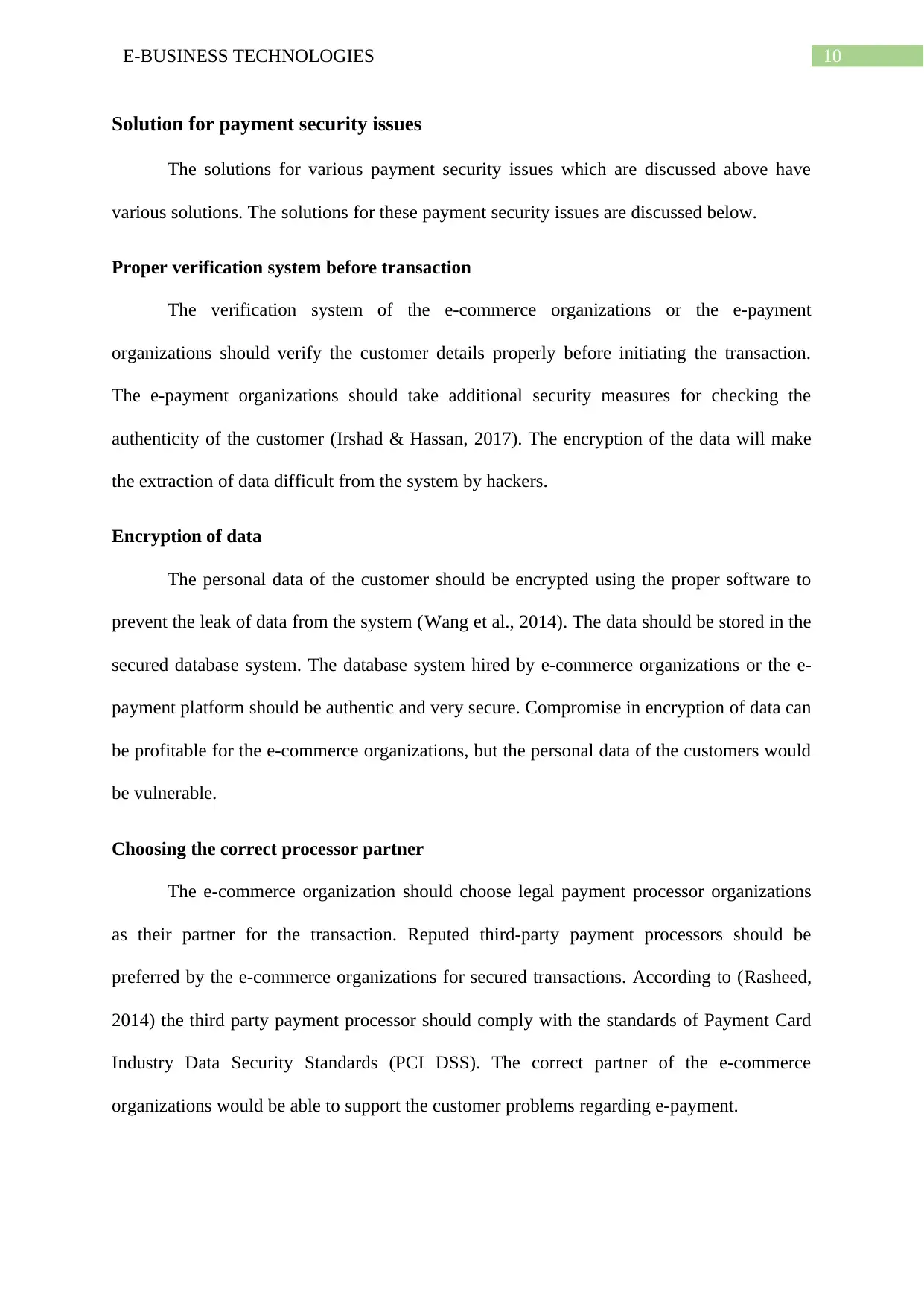
10E-BUSINESS TECHNOLOGIES
Solution for payment security issues
The solutions for various payment security issues which are discussed above have
various solutions. The solutions for these payment security issues are discussed below.
Proper verification system before transaction
The verification system of the e-commerce organizations or the e-payment
organizations should verify the customer details properly before initiating the transaction.
The e-payment organizations should take additional security measures for checking the
authenticity of the customer (Irshad & Hassan, 2017). The encryption of the data will make
the extraction of data difficult from the system by hackers.
Encryption of data
The personal data of the customer should be encrypted using the proper software to
prevent the leak of data from the system (Wang et al., 2014). The data should be stored in the
secured database system. The database system hired by e-commerce organizations or the e-
payment platform should be authentic and very secure. Compromise in encryption of data can
be profitable for the e-commerce organizations, but the personal data of the customers would
be vulnerable.
Choosing the correct processor partner
The e-commerce organization should choose legal payment processor organizations
as their partner for the transaction. Reputed third-party payment processors should be
preferred by the e-commerce organizations for secured transactions. According to (Rasheed,
2014) the third party payment processor should comply with the standards of Payment Card
Industry Data Security Standards (PCI DSS). The correct partner of the e-commerce
organizations would be able to support the customer problems regarding e-payment.
Solution for payment security issues
The solutions for various payment security issues which are discussed above have
various solutions. The solutions for these payment security issues are discussed below.
Proper verification system before transaction
The verification system of the e-commerce organizations or the e-payment
organizations should verify the customer details properly before initiating the transaction.
The e-payment organizations should take additional security measures for checking the
authenticity of the customer (Irshad & Hassan, 2017). The encryption of the data will make
the extraction of data difficult from the system by hackers.
Encryption of data
The personal data of the customer should be encrypted using the proper software to
prevent the leak of data from the system (Wang et al., 2014). The data should be stored in the
secured database system. The database system hired by e-commerce organizations or the e-
payment platform should be authentic and very secure. Compromise in encryption of data can
be profitable for the e-commerce organizations, but the personal data of the customers would
be vulnerable.
Choosing the correct processor partner
The e-commerce organization should choose legal payment processor organizations
as their partner for the transaction. Reputed third-party payment processors should be
preferred by the e-commerce organizations for secured transactions. According to (Rasheed,
2014) the third party payment processor should comply with the standards of Payment Card
Industry Data Security Standards (PCI DSS). The correct partner of the e-commerce
organizations would be able to support the customer problems regarding e-payment.
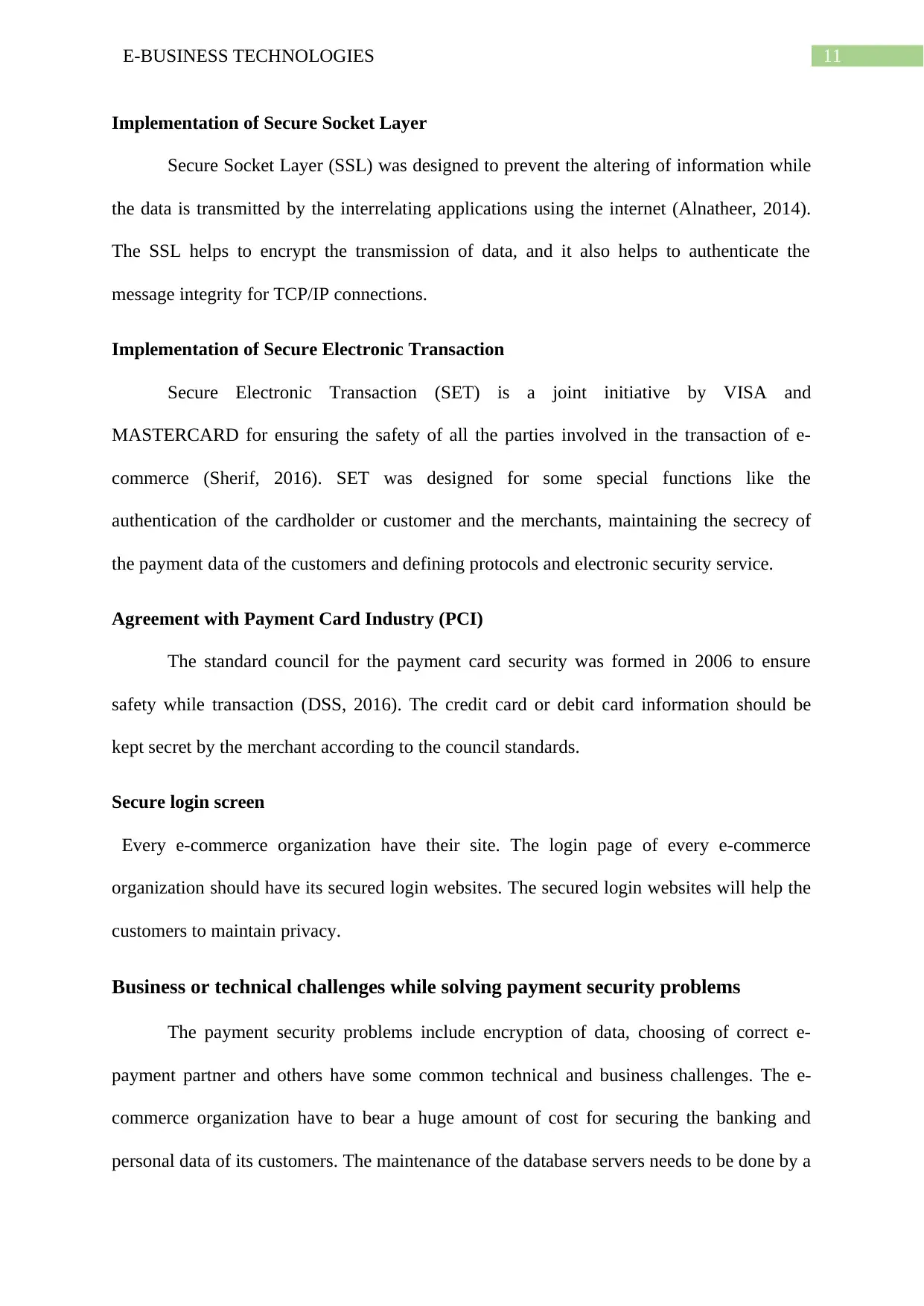
11E-BUSINESS TECHNOLOGIES
Implementation of Secure Socket Layer
Secure Socket Layer (SSL) was designed to prevent the altering of information while
the data is transmitted by the interrelating applications using the internet (Alnatheer, 2014).
The SSL helps to encrypt the transmission of data, and it also helps to authenticate the
message integrity for TCP/IP connections.
Implementation of Secure Electronic Transaction
Secure Electronic Transaction (SET) is a joint initiative by VISA and
MASTERCARD for ensuring the safety of all the parties involved in the transaction of e-
commerce (Sherif, 2016). SET was designed for some special functions like the
authentication of the cardholder or customer and the merchants, maintaining the secrecy of
the payment data of the customers and defining protocols and electronic security service.
Agreement with Payment Card Industry (PCI)
The standard council for the payment card security was formed in 2006 to ensure
safety while transaction (DSS, 2016). The credit card or debit card information should be
kept secret by the merchant according to the council standards.
Secure login screen
Every e-commerce organization have their site. The login page of every e-commerce
organization should have its secured login websites. The secured login websites will help the
customers to maintain privacy.
Business or technical challenges while solving payment security problems
The payment security problems include encryption of data, choosing of correct e-
payment partner and others have some common technical and business challenges. The e-
commerce organization have to bear a huge amount of cost for securing the banking and
personal data of its customers. The maintenance of the database servers needs to be done by a
Implementation of Secure Socket Layer
Secure Socket Layer (SSL) was designed to prevent the altering of information while
the data is transmitted by the interrelating applications using the internet (Alnatheer, 2014).
The SSL helps to encrypt the transmission of data, and it also helps to authenticate the
message integrity for TCP/IP connections.
Implementation of Secure Electronic Transaction
Secure Electronic Transaction (SET) is a joint initiative by VISA and
MASTERCARD for ensuring the safety of all the parties involved in the transaction of e-
commerce (Sherif, 2016). SET was designed for some special functions like the
authentication of the cardholder or customer and the merchants, maintaining the secrecy of
the payment data of the customers and defining protocols and electronic security service.
Agreement with Payment Card Industry (PCI)
The standard council for the payment card security was formed in 2006 to ensure
safety while transaction (DSS, 2016). The credit card or debit card information should be
kept secret by the merchant according to the council standards.
Secure login screen
Every e-commerce organization have their site. The login page of every e-commerce
organization should have its secured login websites. The secured login websites will help the
customers to maintain privacy.
Business or technical challenges while solving payment security problems
The payment security problems include encryption of data, choosing of correct e-
payment partner and others have some common technical and business challenges. The e-
commerce organization have to bear a huge amount of cost for securing the banking and
personal data of its customers. The maintenance of the database servers needs to be done by a

12E-BUSINESS TECHNOLOGIES
specialized technician who is capable of maintaining the security of the database system. The
customer always wants a faster and safer transaction. The main challenge of the e-commerce
organization and the e-payment platform is to maintain the speed and security of the
transaction simultaneously.
Every e-commerce organization have to comply with the PCI, violation of which can
lead to a heavy fine. The detection and prevention of any fraud case while executing a fast
transfer is the main challenge. The real time fraud checking is one of the most important
aspects of maintaining security.
The future of information and payment security trends in e-commerce
The payment security is reaching towards a new horizon with the massive
development in the field of computer science technology. The future of the payment security
trends in e-commerce is
Real-time security
The transaction of money will happen instantly, for that the merchant will have to
verify the identity of the customers in real time (Isaac & Sherali, 2014). The customer will
have to give the required password or authentication code in the form of thumb impression or
digital signature for purchasing any product from the merchant
MasterCard identity checking:
MasterCard started a new initiative for securing e-payment methods. This new
process is often termed as selfie pay. The customer will have to verify their identity with a
photo of their face or with a digital fingerprint.
Multilayered intelligence
Multilayered intelligence is a type of software in the system of the merchant which have
existing customer knowledge. Different question is asked to the customer, and the
specialized technician who is capable of maintaining the security of the database system. The
customer always wants a faster and safer transaction. The main challenge of the e-commerce
organization and the e-payment platform is to maintain the speed and security of the
transaction simultaneously.
Every e-commerce organization have to comply with the PCI, violation of which can
lead to a heavy fine. The detection and prevention of any fraud case while executing a fast
transfer is the main challenge. The real time fraud checking is one of the most important
aspects of maintaining security.
The future of information and payment security trends in e-commerce
The payment security is reaching towards a new horizon with the massive
development in the field of computer science technology. The future of the payment security
trends in e-commerce is
Real-time security
The transaction of money will happen instantly, for that the merchant will have to
verify the identity of the customers in real time (Isaac & Sherali, 2014). The customer will
have to give the required password or authentication code in the form of thumb impression or
digital signature for purchasing any product from the merchant
MasterCard identity checking:
MasterCard started a new initiative for securing e-payment methods. This new
process is often termed as selfie pay. The customer will have to verify their identity with a
photo of their face or with a digital fingerprint.
Multilayered intelligence
Multilayered intelligence is a type of software in the system of the merchant which have
existing customer knowledge. Different question is asked to the customer, and the
Paraphrase This Document
Need a fresh take? Get an instant paraphrase of this document with our AI Paraphraser
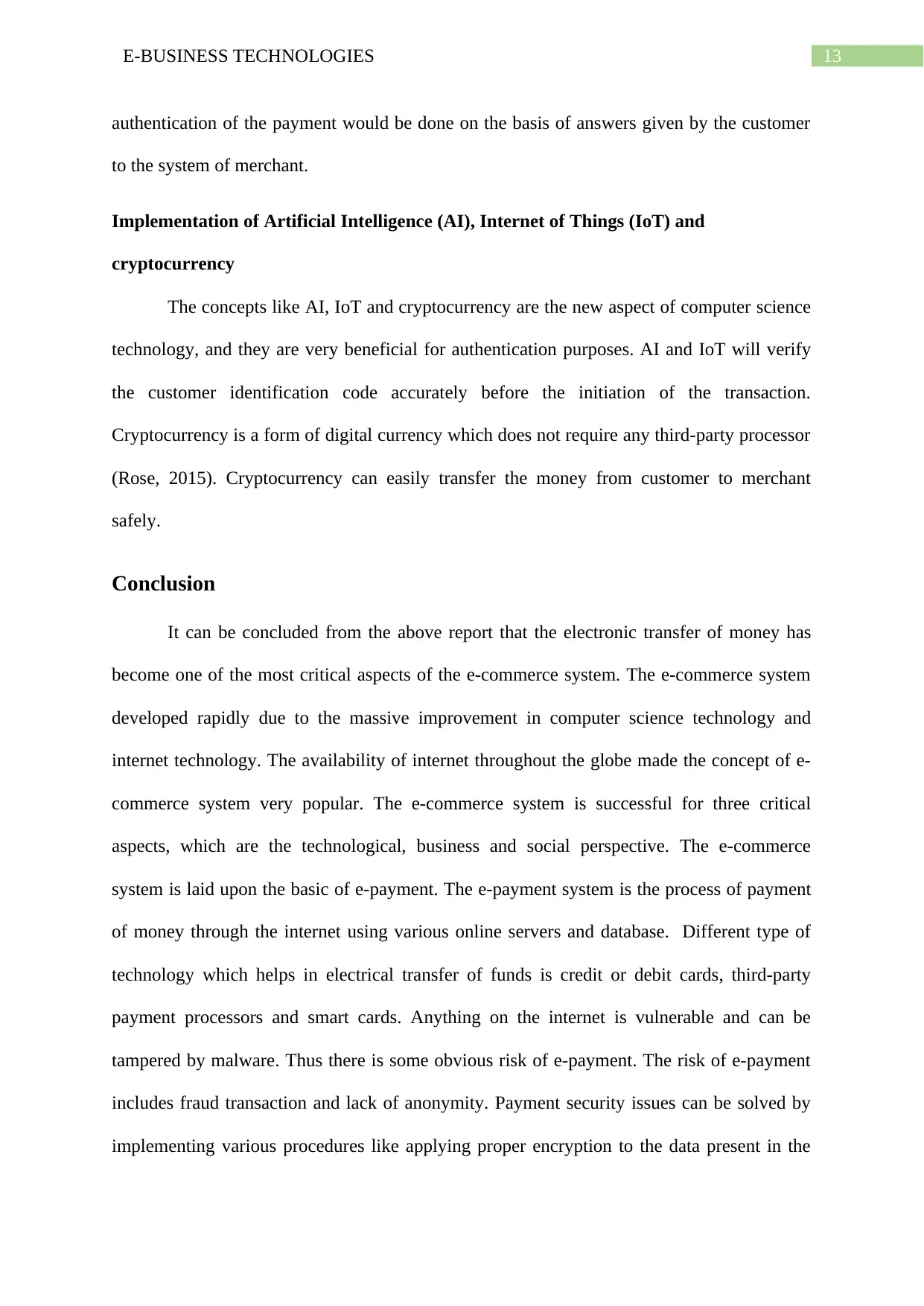
13E-BUSINESS TECHNOLOGIES
authentication of the payment would be done on the basis of answers given by the customer
to the system of merchant.
Implementation of Artificial Intelligence (AI), Internet of Things (IoT) and
cryptocurrency
The concepts like AI, IoT and cryptocurrency are the new aspect of computer science
technology, and they are very beneficial for authentication purposes. AI and IoT will verify
the customer identification code accurately before the initiation of the transaction.
Cryptocurrency is a form of digital currency which does not require any third-party processor
(Rose, 2015). Cryptocurrency can easily transfer the money from customer to merchant
safely.
Conclusion
It can be concluded from the above report that the electronic transfer of money has
become one of the most critical aspects of the e-commerce system. The e-commerce system
developed rapidly due to the massive improvement in computer science technology and
internet technology. The availability of internet throughout the globe made the concept of e-
commerce system very popular. The e-commerce system is successful for three critical
aspects, which are the technological, business and social perspective. The e-commerce
system is laid upon the basic of e-payment. The e-payment system is the process of payment
of money through the internet using various online servers and database. Different type of
technology which helps in electrical transfer of funds is credit or debit cards, third-party
payment processors and smart cards. Anything on the internet is vulnerable and can be
tampered by malware. Thus there is some obvious risk of e-payment. The risk of e-payment
includes fraud transaction and lack of anonymity. Payment security issues can be solved by
implementing various procedures like applying proper encryption to the data present in the
authentication of the payment would be done on the basis of answers given by the customer
to the system of merchant.
Implementation of Artificial Intelligence (AI), Internet of Things (IoT) and
cryptocurrency
The concepts like AI, IoT and cryptocurrency are the new aspect of computer science
technology, and they are very beneficial for authentication purposes. AI and IoT will verify
the customer identification code accurately before the initiation of the transaction.
Cryptocurrency is a form of digital currency which does not require any third-party processor
(Rose, 2015). Cryptocurrency can easily transfer the money from customer to merchant
safely.
Conclusion
It can be concluded from the above report that the electronic transfer of money has
become one of the most critical aspects of the e-commerce system. The e-commerce system
developed rapidly due to the massive improvement in computer science technology and
internet technology. The availability of internet throughout the globe made the concept of e-
commerce system very popular. The e-commerce system is successful for three critical
aspects, which are the technological, business and social perspective. The e-commerce
system is laid upon the basic of e-payment. The e-payment system is the process of payment
of money through the internet using various online servers and database. Different type of
technology which helps in electrical transfer of funds is credit or debit cards, third-party
payment processors and smart cards. Anything on the internet is vulnerable and can be
tampered by malware. Thus there is some obvious risk of e-payment. The risk of e-payment
includes fraud transaction and lack of anonymity. Payment security issues can be solved by
implementing various procedures like applying proper encryption to the data present in the
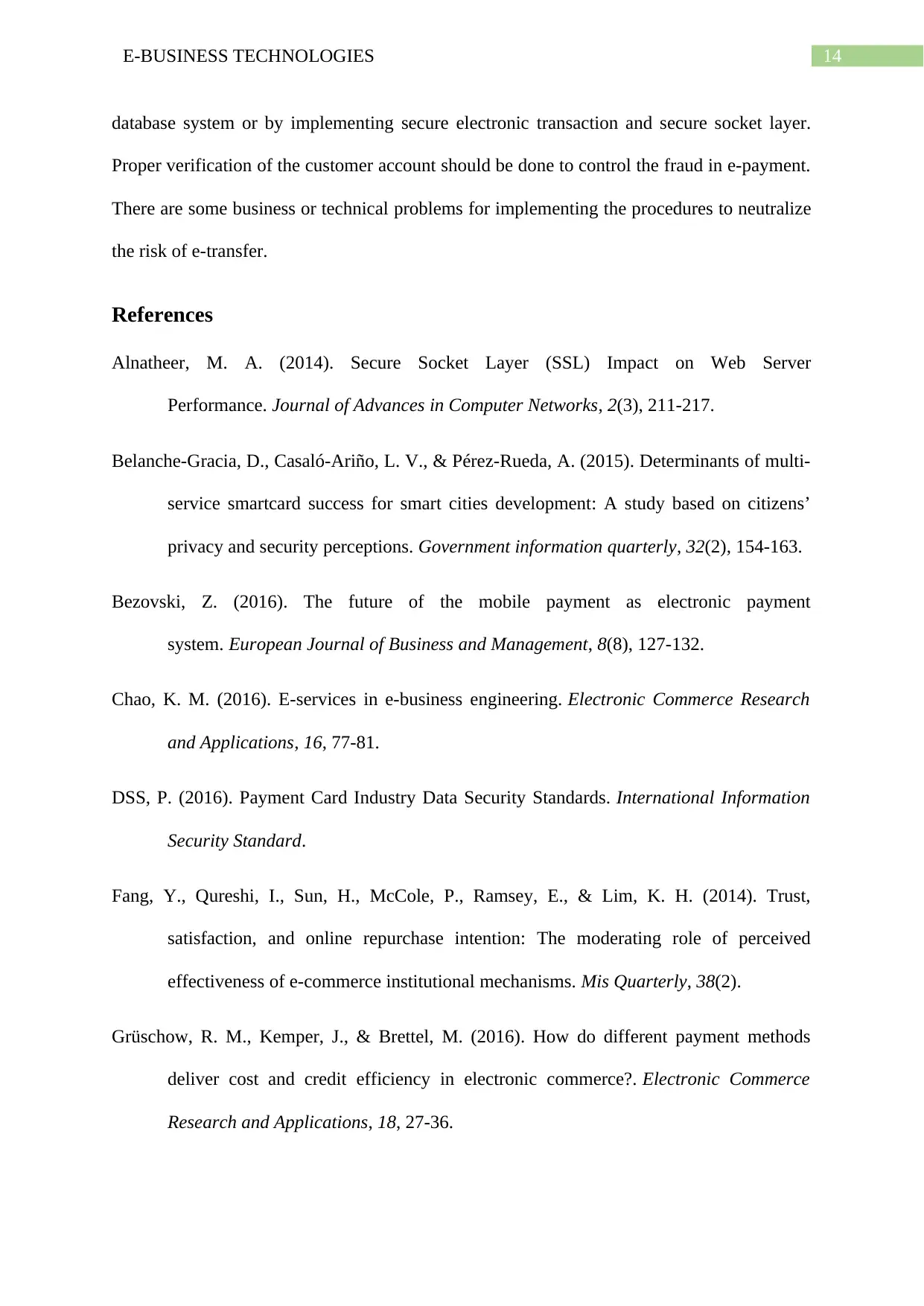
14E-BUSINESS TECHNOLOGIES
database system or by implementing secure electronic transaction and secure socket layer.
Proper verification of the customer account should be done to control the fraud in e-payment.
There are some business or technical problems for implementing the procedures to neutralize
the risk of e-transfer.
References
Alnatheer, M. A. (2014). Secure Socket Layer (SSL) Impact on Web Server
Performance. Journal of Advances in Computer Networks, 2(3), 211-217.
Belanche-Gracia, D., Casaló-Ariño, L. V., & Pérez-Rueda, A. (2015). Determinants of multi-
service smartcard success for smart cities development: A study based on citizens’
privacy and security perceptions. Government information quarterly, 32(2), 154-163.
Bezovski, Z. (2016). The future of the mobile payment as electronic payment
system. European Journal of Business and Management, 8(8), 127-132.
Chao, K. M. (2016). E-services in e-business engineering. Electronic Commerce Research
and Applications, 16, 77-81.
DSS, P. (2016). Payment Card Industry Data Security Standards. International Information
Security Standard.
Fang, Y., Qureshi, I., Sun, H., McCole, P., Ramsey, E., & Lim, K. H. (2014). Trust,
satisfaction, and online repurchase intention: The moderating role of perceived
effectiveness of e-commerce institutional mechanisms. Mis Quarterly, 38(2).
Grüschow, R. M., Kemper, J., & Brettel, M. (2016). How do different payment methods
deliver cost and credit efficiency in electronic commerce?. Electronic Commerce
Research and Applications, 18, 27-36.
database system or by implementing secure electronic transaction and secure socket layer.
Proper verification of the customer account should be done to control the fraud in e-payment.
There are some business or technical problems for implementing the procedures to neutralize
the risk of e-transfer.
References
Alnatheer, M. A. (2014). Secure Socket Layer (SSL) Impact on Web Server
Performance. Journal of Advances in Computer Networks, 2(3), 211-217.
Belanche-Gracia, D., Casaló-Ariño, L. V., & Pérez-Rueda, A. (2015). Determinants of multi-
service smartcard success for smart cities development: A study based on citizens’
privacy and security perceptions. Government information quarterly, 32(2), 154-163.
Bezovski, Z. (2016). The future of the mobile payment as electronic payment
system. European Journal of Business and Management, 8(8), 127-132.
Chao, K. M. (2016). E-services in e-business engineering. Electronic Commerce Research
and Applications, 16, 77-81.
DSS, P. (2016). Payment Card Industry Data Security Standards. International Information
Security Standard.
Fang, Y., Qureshi, I., Sun, H., McCole, P., Ramsey, E., & Lim, K. H. (2014). Trust,
satisfaction, and online repurchase intention: The moderating role of perceived
effectiveness of e-commerce institutional mechanisms. Mis Quarterly, 38(2).
Grüschow, R. M., Kemper, J., & Brettel, M. (2016). How do different payment methods
deliver cost and credit efficiency in electronic commerce?. Electronic Commerce
Research and Applications, 18, 27-36.
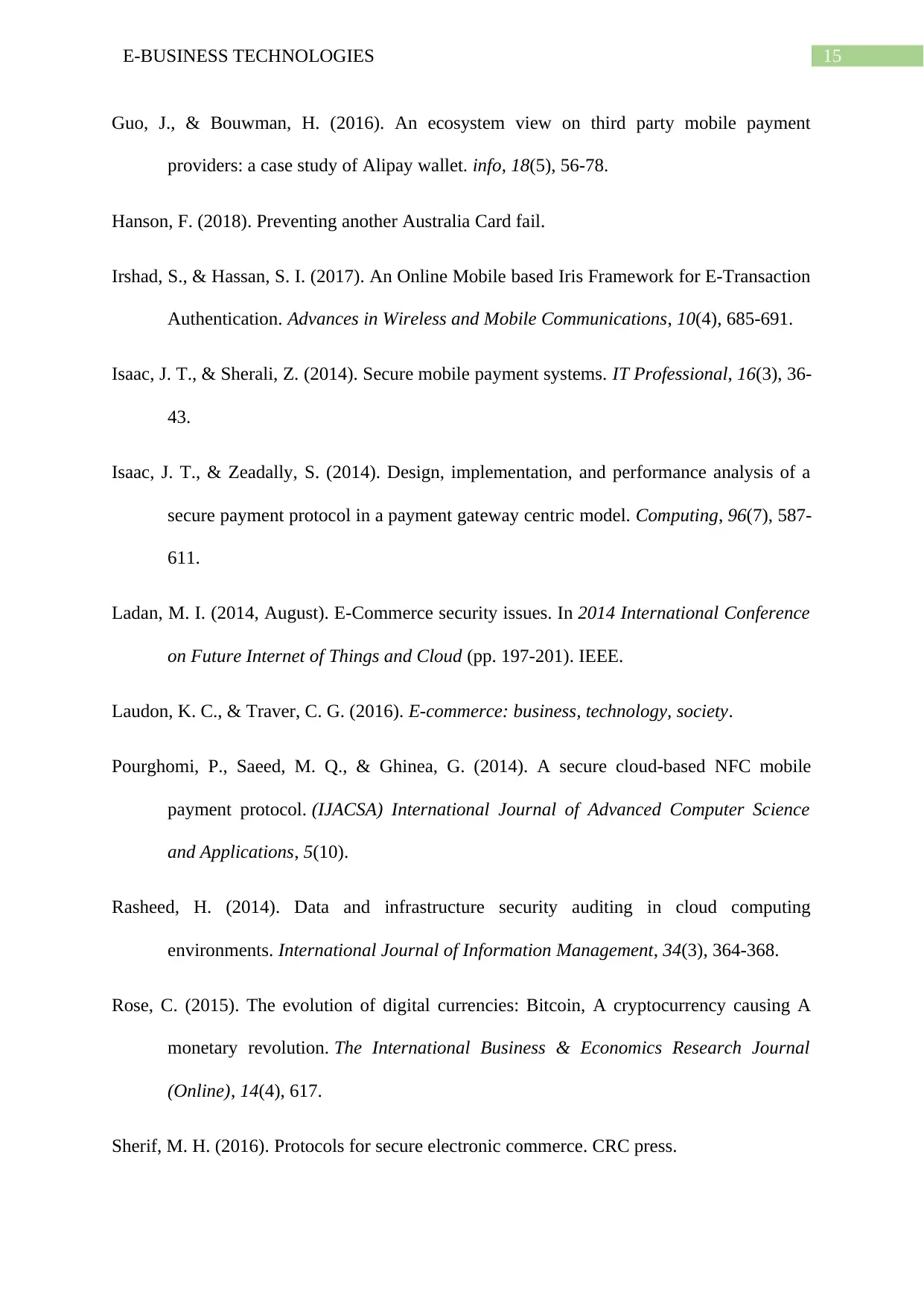
15E-BUSINESS TECHNOLOGIES
Guo, J., & Bouwman, H. (2016). An ecosystem view on third party mobile payment
providers: a case study of Alipay wallet. info, 18(5), 56-78.
Hanson, F. (2018). Preventing another Australia Card fail.
Irshad, S., & Hassan, S. I. (2017). An Online Mobile based Iris Framework for E-Transaction
Authentication. Advances in Wireless and Mobile Communications, 10(4), 685-691.
Isaac, J. T., & Sherali, Z. (2014). Secure mobile payment systems. IT Professional, 16(3), 36-
43.
Isaac, J. T., & Zeadally, S. (2014). Design, implementation, and performance analysis of a
secure payment protocol in a payment gateway centric model. Computing, 96(7), 587-
611.
Ladan, M. I. (2014, August). E-Commerce security issues. In 2014 International Conference
on Future Internet of Things and Cloud (pp. 197-201). IEEE.
Laudon, K. C., & Traver, C. G. (2016). E-commerce: business, technology, society.
Pourghomi, P., Saeed, M. Q., & Ghinea, G. (2014). A secure cloud-based NFC mobile
payment protocol. (IJACSA) International Journal of Advanced Computer Science
and Applications, 5(10).
Rasheed, H. (2014). Data and infrastructure security auditing in cloud computing
environments. International Journal of Information Management, 34(3), 364-368.
Rose, C. (2015). The evolution of digital currencies: Bitcoin, A cryptocurrency causing A
monetary revolution. The International Business & Economics Research Journal
(Online), 14(4), 617.
Sherif, M. H. (2016). Protocols for secure electronic commerce. CRC press.
Guo, J., & Bouwman, H. (2016). An ecosystem view on third party mobile payment
providers: a case study of Alipay wallet. info, 18(5), 56-78.
Hanson, F. (2018). Preventing another Australia Card fail.
Irshad, S., & Hassan, S. I. (2017). An Online Mobile based Iris Framework for E-Transaction
Authentication. Advances in Wireless and Mobile Communications, 10(4), 685-691.
Isaac, J. T., & Sherali, Z. (2014). Secure mobile payment systems. IT Professional, 16(3), 36-
43.
Isaac, J. T., & Zeadally, S. (2014). Design, implementation, and performance analysis of a
secure payment protocol in a payment gateway centric model. Computing, 96(7), 587-
611.
Ladan, M. I. (2014, August). E-Commerce security issues. In 2014 International Conference
on Future Internet of Things and Cloud (pp. 197-201). IEEE.
Laudon, K. C., & Traver, C. G. (2016). E-commerce: business, technology, society.
Pourghomi, P., Saeed, M. Q., & Ghinea, G. (2014). A secure cloud-based NFC mobile
payment protocol. (IJACSA) International Journal of Advanced Computer Science
and Applications, 5(10).
Rasheed, H. (2014). Data and infrastructure security auditing in cloud computing
environments. International Journal of Information Management, 34(3), 364-368.
Rose, C. (2015). The evolution of digital currencies: Bitcoin, A cryptocurrency causing A
monetary revolution. The International Business & Economics Research Journal
(Online), 14(4), 617.
Sherif, M. H. (2016). Protocols for secure electronic commerce. CRC press.
Secure Best Marks with AI Grader
Need help grading? Try our AI Grader for instant feedback on your assignments.

16E-BUSINESS TECHNOLOGIES
Sivapalan, S., Sadeghian, A., Rahnama, H., & Madni, A. M. (2014, August). Recommender
systems in e-commerce. In 2014 World Automation Congress (WAC) (pp. 179-184).
IEEE.
Trautman, L. J. (2015). E-Commerce, cyber, and electronic payment system risks: lessons
from PayPal. UC Davis Bus. LJ, 16, 261.
Varsha, R., & Thulasiram, M. (2016). Acceptance of e-wallet services: A study of consumer
behavior. International Journal of Innovative Research in Management Studies, 1(4),
2455-7188.
Wang, X., Zhang, J., Schooler, E. M., & Ion, M. (2014, June). Performance evaluation of
attribute-based encryption: Toward data privacy in the IoT. In 2014 IEEE
International Conference on Communications (ICC) (pp. 725-730). IEEE.
Yang, J. H., & Lin, P. Y. (2016). A mobile payment mechanism with anonymity for cloud
computing. Journal of Systems and Software, 116, 69-74.
Zhao, J., Lau, R. Y., Zhang, W., Zhang, K., Chen, X., & Tang, D. (2016). Extracting and
reasoning about implicit behavioral evidences for detecting fraudulent online
transactions in e-Commerce. Decision support systems, 86, 109-121.
Sivapalan, S., Sadeghian, A., Rahnama, H., & Madni, A. M. (2014, August). Recommender
systems in e-commerce. In 2014 World Automation Congress (WAC) (pp. 179-184).
IEEE.
Trautman, L. J. (2015). E-Commerce, cyber, and electronic payment system risks: lessons
from PayPal. UC Davis Bus. LJ, 16, 261.
Varsha, R., & Thulasiram, M. (2016). Acceptance of e-wallet services: A study of consumer
behavior. International Journal of Innovative Research in Management Studies, 1(4),
2455-7188.
Wang, X., Zhang, J., Schooler, E. M., & Ion, M. (2014, June). Performance evaluation of
attribute-based encryption: Toward data privacy in the IoT. In 2014 IEEE
International Conference on Communications (ICC) (pp. 725-730). IEEE.
Yang, J. H., & Lin, P. Y. (2016). A mobile payment mechanism with anonymity for cloud
computing. Journal of Systems and Software, 116, 69-74.
Zhao, J., Lau, R. Y., Zhang, W., Zhang, K., Chen, X., & Tang, D. (2016). Extracting and
reasoning about implicit behavioral evidences for detecting fraudulent online
transactions in e-Commerce. Decision support systems, 86, 109-121.
1 out of 17
Related Documents
Your All-in-One AI-Powered Toolkit for Academic Success.
+13062052269
info@desklib.com
Available 24*7 on WhatsApp / Email
![[object Object]](/_next/static/media/star-bottom.7253800d.svg)
Unlock your academic potential
© 2024 | Zucol Services PVT LTD | All rights reserved.





